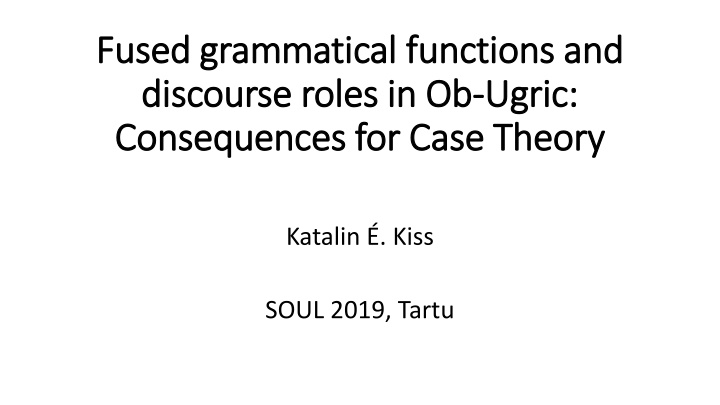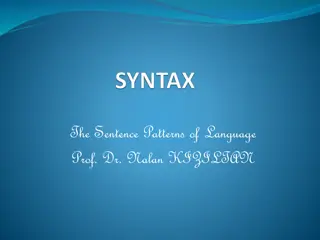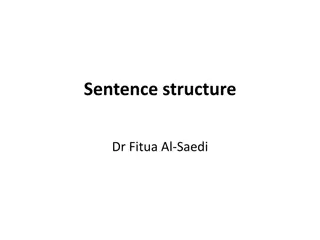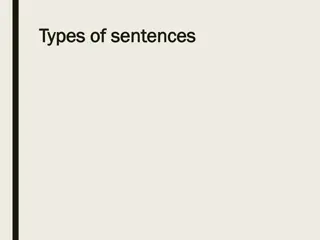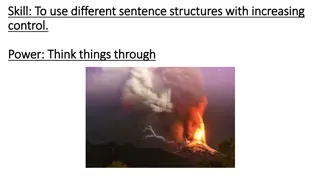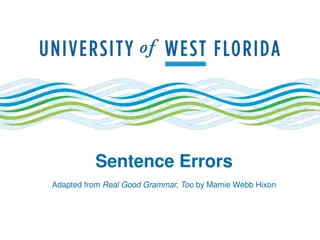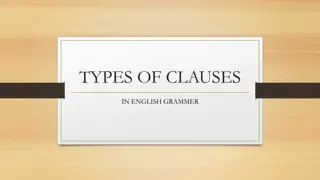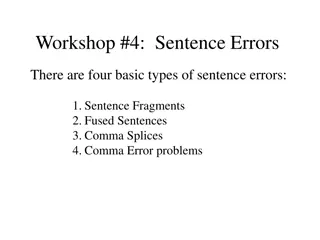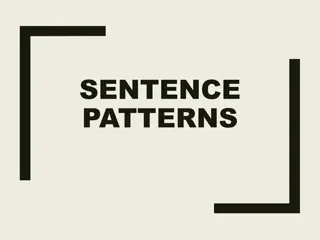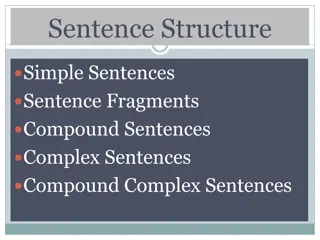Challenges in Ob-Ugric Sentence Structure
The Ob-Ugric language exhibits a unique fusion of grammatical functions and discourse roles, presenting challenges to traditional case theory. This system involves the fusion of topic and subject roles, divorcing object licensing, and promoting topicalized goal arguments to objects. The language also showcases passivization in various sentence structures, with theoretical implications on NP movement driven by discourse requirements.
Download Presentation

Please find below an Image/Link to download the presentation.
The content on the website is provided AS IS for your information and personal use only. It may not be sold, licensed, or shared on other websites without obtaining consent from the author.If you encounter any issues during the download, it is possible that the publisher has removed the file from their server.
You are allowed to download the files provided on this website for personal or commercial use, subject to the condition that they are used lawfully. All files are the property of their respective owners.
The content on the website is provided AS IS for your information and personal use only. It may not be sold, licensed, or shared on other websites without obtaining consent from the author.
E N D
Presentation Transcript
Fused Fused grammatical grammatical functions discourse discourse roles roles in in Ob Consequences for Case Theory Consequences for Case Theory functions and Ob- -Ugric: Ugric: and Katalin . Kiss SOUL 2019, Tartu
Claims: The Ob-Ugric sentence displays a partial fusion of grammatial functions and discourse roles; this system presents challenges to Chomskyan case theory.
Road map: 1. Fusion of the topic and subject roles via passivization - multiple case assignment (nominative overwriting oblique) 2. Partial fusion of the secondary topic and object roles - divorcing object licensing and accusative assignment 3. Topicalized goal arguments are promoted to object - lexical (vs. syntactic) derivation? 4. Oblique subjects functioning as shifted topics - multiple case assignment (oblique overwriting nominative)?
The Ob-Ugric subject is also primary topic Petra u:r-na Peter forest-LOC Peter saw a bear in the forest. [VPmo:jp r wa:nt- s] bear (Khanty) (1) see- PAST.3SG If the deep subject is [-specific], passivization: (2)a. pro t p t-j he seventy He was pierced by seventy arrows. b. wram por-n -n child Por-woman-LAT The child was taken by a Por woman. ot-n arrow-LOC pierce-PASS.3SG pet-aj (Khanty) tot-we-s take-PASS-PAST.3SG (Mansi)
A minimal pair: (3)a. *Xoj Juwan re:sk- s? who Ivan hit-PAST.3SG Who hit Ivan? (Khanty) b. Juwan Ivan Who was Ivan hit by? xoj-na who-LOC re:sk- s-a? hit-PAST-PASS.3SG
Passivization also in case of unergatives and unaccusatives (4) a. M w w- n earth mist-LOC Mist is sitting on the earth. Lit.: The earth is sat on by mist. m s- -a. sit.down-PRES-PASS.3SG (Khanty) b. N tak you Guests will come to you. Lit.: You will be come to by guests. mujn t-n j t-w- n. guest.PL-LAT come-PASS-2SG (Mansi) so
Passivization also in presentative sentences (5)a. puwl psi-na tumor-LOC A tumor appeared. Lit.: (pro) was entered by a tumor. e:t-s-a. enter-PAST-PASS.3SG (Khanty) b. k -m st suddenly Suddenly a man appeared. Lit.: Suddenly, (there) was appeared by a man. k mn man-LAT t wl- w-s appear-PASS-PAST.3SG Mansi
Theoretical implications i. Ob-Ugric NP movement is motivated by discourse requirements (rather than case requirements) ii. The argument to be promoted to subject does not move for case; it can have inherent case - cf. (6)a. Nare:-l ox s-na xu:j-l-a bench-3SG sable-LOC lie-PRES-PASS.3SG 'There are sables lying on his bench.' b. pro Kul'-na joxet-s-a devil-LOC come-PAST-PASS.3SG 'A devil came to him.' (Khanty)
What happens to the locative/lative case of the argument to be promoted to subject? NP-movement involves dual case-assignment; the new nominative case overwrites the existing oblique case. (Cf. Richards 2013 on English pseudo-passives; Chen 2018 on Amis, etc.)
Focus objects versus topic objects Focussed objects: VP-internal no agreement (7)a. Petra u:r-na [VPmo:jp r Peter forest-LOC Peter saw a bear in the forest. wa:nt- s] see- PAST.3SG (Khanty) bear Topicalized objects: VP-external, O-V agreement b. Petra mo:jp r Peter bear Peter saw the bear in the forest. u:r-na forest-LOC [VPwa:nt-s -lli ] see-PAST-SG<3SG
An agreeing object is in a derived position A floating quatifier marks the base position of the object: (8)a. Luw [VPasa a:n- t (*asa) il he all cup-PL all He dropped all the cups. pa:j t- s] down (Khanty) drop-PAST.3SG b. Luw he All the cups, he dropped. asa all a:n- t [VP(asa) cup-PL il down drop-PAST-SG<3SG pa:j t-s -lli] all
Semantic evidence of topicalization: (9) a. What did you do? (Khanty) Ma tam kala I this reindeer I killed this reindeer. we:l-s- m kill-PAST-1SG/kill-PAST-SG<1SG /*we:l-s-e:m b. What did you do with this reindeer? Ma tam kala I this reindeer I killed this reindeer. *we:l-s- m /we:l-s-e:m kill-PAST-1SG/kill-PAST-SG<1SG
Topicalized objects bear ACC in Eastern Mansi (10)a. kom jowt-ny l w -s man bow-arrow take-PAST.3SG The man took a bow and an arrow (E Mansi) b. w-m door-ACC I don t find the door. t NEG kont-iil- m find-SG<1SG
Relics of the accusative marking of secondary topics in Vasyugan Khanty (11)a. p - l-n son-3SG-LOC long she call-PST.3SG Her son called her for a long time. qo ju wa a- n. (Vasyugan Khanty) b. n - t you-ACC what name-INS call-PRES-3PL What name do they call you? m i nemp- wa -w lt?
Mansi AgrSP Khanty AgrS NP1 AgrS NP1 AgrS AgrOP AgrS AgrOP AgrS [+nom, +topic] [+nom, +topic] NP2 AgrO NP2 AgrO TP AgrO VoiceP AgrO [+acc, +topic] T [+acc, +topic] Voice VoiceP T TP Voice Voice T1 VP Voice VP T [+/-active] V V V V
Is the caseless object pseudo-incorporated into the V? No, because it can be referential: (12) ton k n-p l-n seem l-nyox s, s jr ng-nyox s j lp- ng that up-side-LAT black-sable white-sable sacred-ADJ to gl- t cloth-POSS.3SG up-pull-PAST.3SG Upon that, he put on his sacred costume of black sable, white sable. nok-posyg- s. (E Mansi; Virtanen 2014: (25))
Is the VP-internal object caseless? Shall we give up the Case filter? Another option: to divorce syntactic Case (object licensing) and morphological case; to assume that the object is licensed by the V under government, and its accusative case is assigned by AgrO in a specifier head configuration (Bobaljik 2017)
Topicalization of a goal via promotion to object (13)a. Who do you relate the tale to? Am m jt tawen I tale I relate the tale to him. b. What do you tell him? Am tawe I he.ACC I tell him a tale. mojt-i-lum. tell-PRS-SG<1SG (N Mansi) he.LAT m jt- l tale-INSTR m jt-i-lum. tell-PRS-SG<1SG
Secundative structure with non-topic goal? (14) Nata a Nata a Natasa gave Ksu a a book. Ksu a n p k-at Ksu a book-INS m j. give.PAST.3SG (Khanty; F. Guly s)
Semantic difference between the two variants (15)a. w mantem (s)he I.DAT She gave two fish to me. kat two qu - n fish-DU m j. give-PAST.3SG Khanty b. w mant kat (s)he I.ACC two She provided me with 2 fish. qu - n-at fish-DU-INS m j. give-PAST.3SG
Is the relation between the directive and secundative constructions derivational? No - cf. current views about the English double object structure: Uniform Multiple Meaning Approach (Beck & Johnson 2004; etc): caused motion vs. caused possession Single Meaning Approach (Rappaport Hovav and Levin 2008): give: only transfer of possession; difference only in information structure. Different argument realization only in languages with rigid word order.
Oblique subjects in active sentences (16)a. so:r i-na gold-LOC The gold is floating down. pos-ij- l. float-IMPF-PRES.3SG (N Khanty) b. pan and this And this little boy knows it tom j one po - i-n boy-DEM.LOC know-PRS-SG>3SG wu- -t . (E Khanty) c. Sidar w p k n-n to ajrit-n Sidar late gun-LOC also canoe-LOC lie-PRES.3SG 'Late Sidar's gun also lies in the boat.' ola -w l (Vasyugan Khanty)
The status of locative subjects Not ergative subjects (contra Baker (2015)) because they also occur with unaccusative Vs and transitive Vs. Not Icelandic-type quirky subjects because not lexically constrained. Not locative agents but locative subjects of all kinds
Locative subjects Filchenko (2007), Sosa (2017): An active subject can bear locative case if it functions as a temporarily foregrounded shifted topic. A parallel with Amis contrastive topics (Cheng 2018)? Amis: subjects of perfective clauses receive genitive case, and also an additional nominative case when they are contrastive topics. Khanty: subjects get an additional locative case when they move on to a functional projection to check their contrastive feature?
Selected references Baker, M. 2015. Case. Cambridge University Press. Beck, S. & K. Johnson. 2004. Double objects again. Linguistic Inquiry 35:97-123. Bobaljik, J. 2008. Where is phi? Agreement as a post-syntactic operation. In: Harbour et al. (eds), Phi-Theory: Phi features across interfaces and modules. OUP, 295-328. Chen, Tingchun 2018. Multiple Case Assignment: An Amis Case Study. PhD MIT. Filchenko, A. 2007. A grammar of Eastern Khanty. PhD diss., Rice U. Houston. Richards, N. 2017. Multiple case assignment and the English pseudo-passive. In N. LaCara et al. (eds), A Schrift to Fest Kyle Johnson, I. 313 319. Linguistics OAP. Rappaport Hovav, M. and B. Levin 2008. The English Dative Alternation: The Case for Verb Sensitivity'', Journal of Linguistics 44: 129-167. Sosa, S. 2017. Functions of morphosyntactic alternations, and information flow in Surgut Khanty. PhD diss, Helsinki University.
